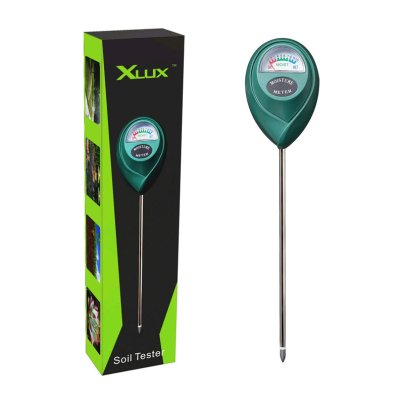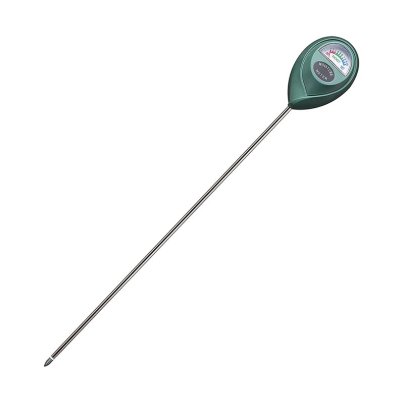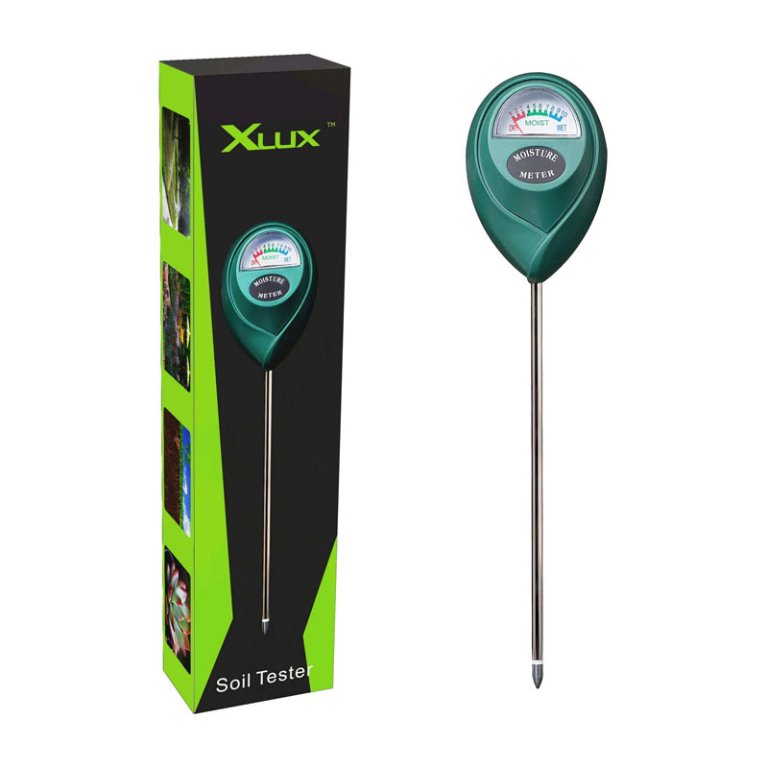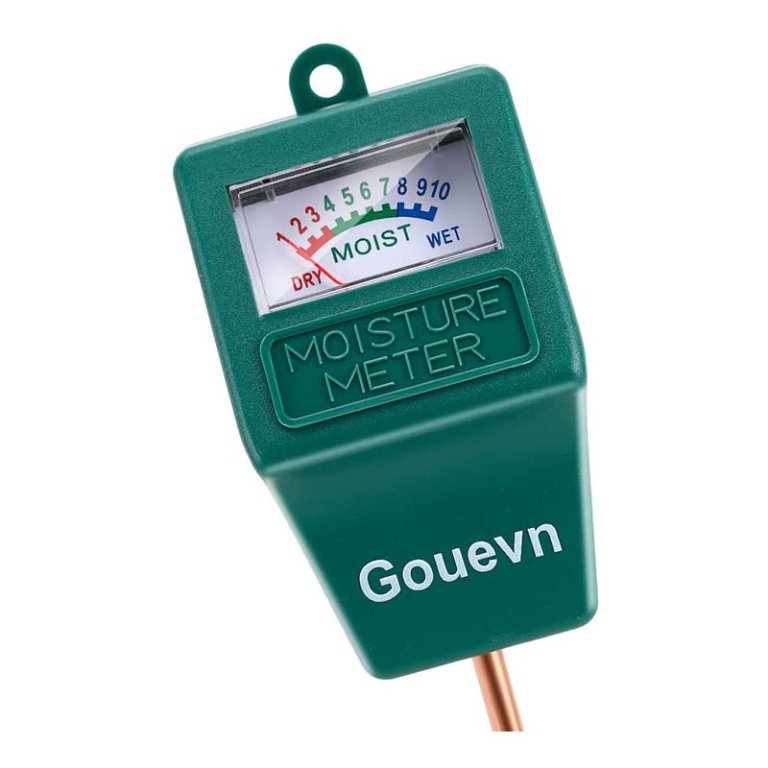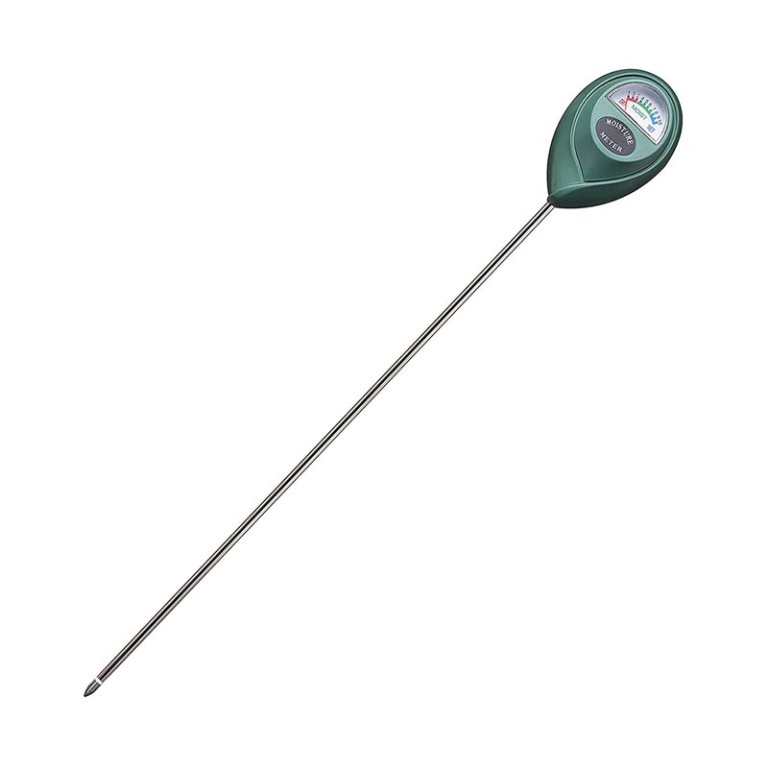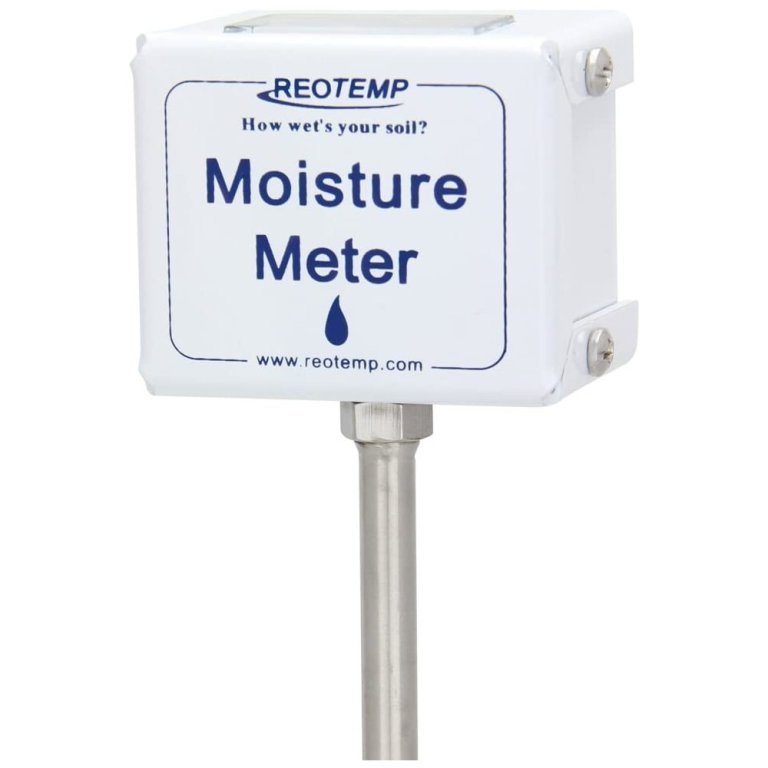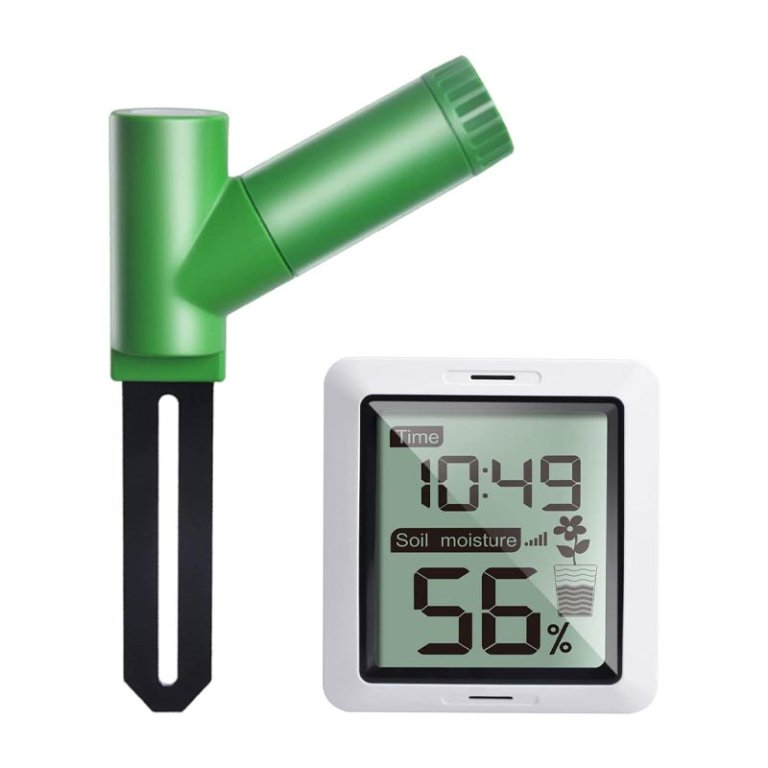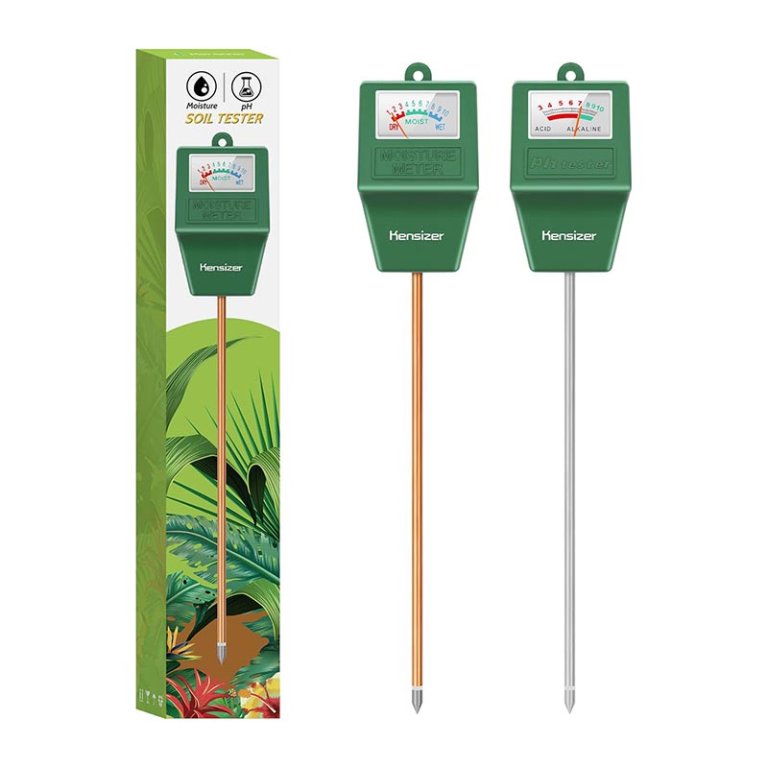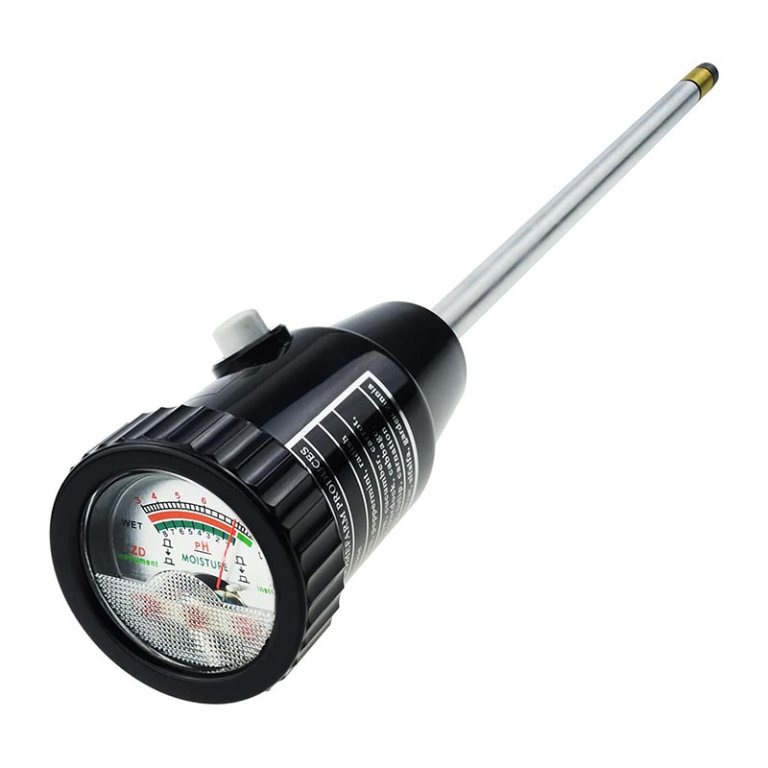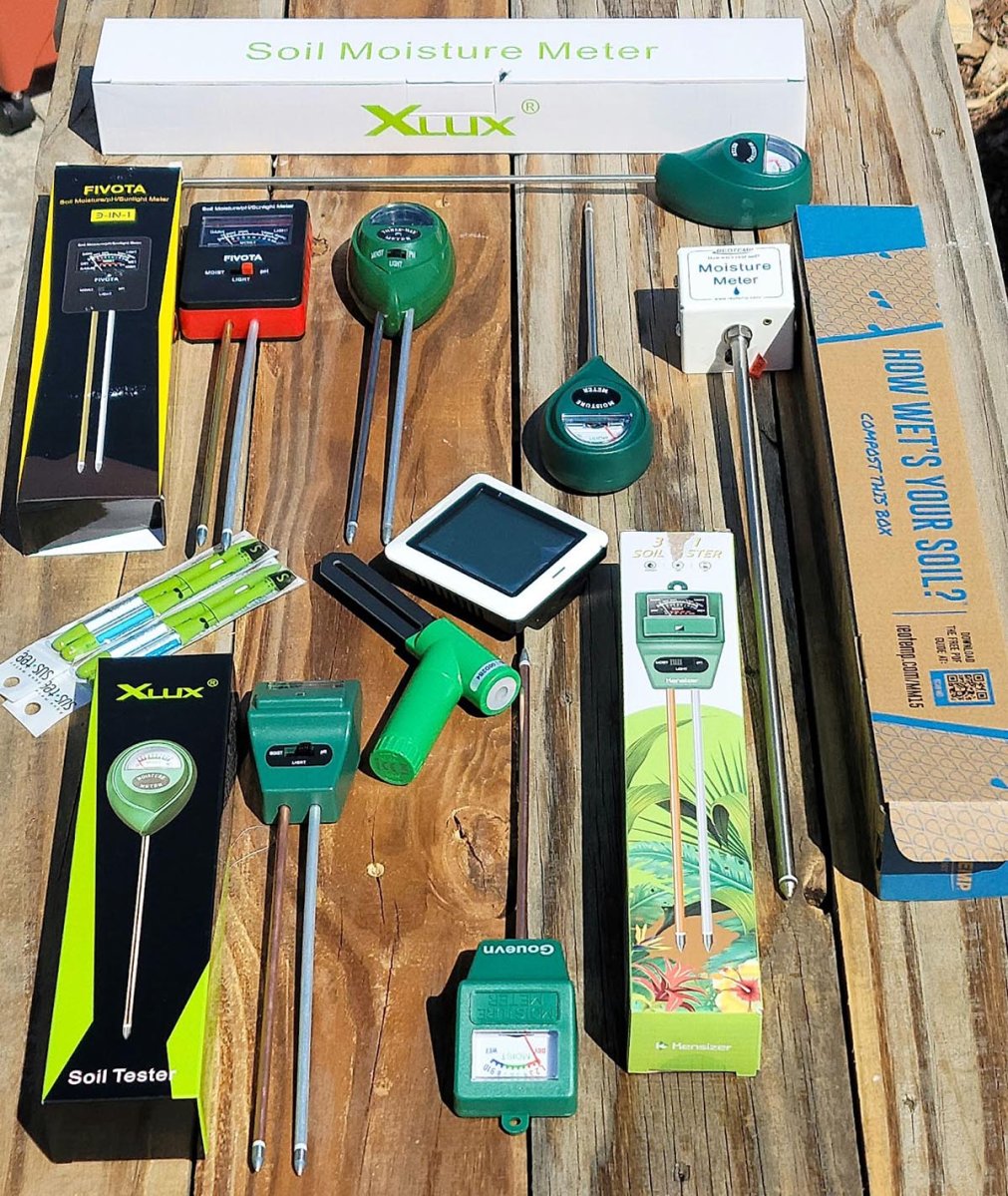
We may earn revenue from the products available on this page and participate in affiliate programs. Learn More ›
Soil moisture meters are simple gardening tools that include sensing probes that detect the level of dampness in soil. They’re touted as the best predictors for watering, so to see if they live up to the hype, we tested the most popular ones available.
To judge their ability to detect moisture differences, we tested ten soil moisture meters in various growing mediums, including potting soil, dirt from the garden, peat moss, and compost. We used them in bone-dry soil and then watered the medium to see how well the meters detected additional moisture. After reviewing our test results, our top pick is the Xlux Soil Moisture Meter for its versatile indoor/outdoor capabilities, analog design, 10-point scale, and ability to provide instant moisture readings without calibration, right out of the box.
Keep reading to learn more about selecting a soil moisture meter and find out the pros and cons of the following models, and which products earned a spot in our roundup of the best soil moisture meters on the market.
- BEST OVERALL: Xlux Soil Moisture Meter
↓ Jump to Review - BEST BANG FOR THE BUCK: Gouevn Soil Moisture Meter
↓ Jump to Review - BEST FOR DEEP POTS: Xlux Long Probe Deep Use Soil Moisture Meter
↓ Jump to Review - BEST FOR COMPOST: Reotemp Garden and Compost Moisture Meter
↓ Jump to Review - BEST DIGITAL: Ecowitt Soil Moisture Tester
↓ Jump to Review - BEST pH MODEL: Kensizer 2-in-1 Soil Moisture/pH Meter
↓ Jump to Review - BEST HEAVY-DUTY: Gain Express Soil pH & Moisture Meter
↓ Jump to Review

Soil Moisture Meters Comparison Chart
| Indoor or Outdoor | Analog or Digital | Additional Functions | |
| Xlux Soil Moisture Meter | Both | Analog | None |
| Gouevn Soil Moisture Meter | Both | Analog | None |
| Xlux Long Probe Deep Use Soil Moisture Meter | Both | Analog | No added functions, but an extra-long probe |
| Reotemp Garden and Compost Moisture Meter | Outdoor | Analog, battery-powered | None |
| Ecowitt Soil Moisture Tester | Indoor | Digital | Clock |
| Kensizer 2-in-1 Soil Moisture/pH Meter | Both | Analog | pH levels |
| Gain Express Soil pH & Moisture Meter | Outdoor | Analog | pH levels |
Our Top Picks
To qualify for a spot in this lineup of the best soil moisture meters, the following models all had to be made from quality materials, be durable enough to insert into semi-dry soil without the probe bending, and be easy to read. We tested a range of meters, from simple analog types to digital ones with accompanying LCD displays. While soil moisture meters are relatively straightforward gardening tools, some are better suited to specific growing situations than others. The following models all met or exceeded our expectations—find out the pros and cons of each one in our reviews.
Best Overall
Xlux Soil Moisture Meter
See ItWhat We Like
- Instant moisture readings for quick testing
- Accurate readings for taking care of plant varieties
- Easy-to-read dial is suitable for first-timers and professionals
What We Don’t Like
- Slightly hard to see in dim lighting
- May not be ideal for light garden work
Specs
- Indoor or outdoor: Both
- Analog or digital: Analog
- Additional functions: None
The Xlux Soil Moisture Meter is the epitome of simplicity—and that’s one of the reasons we loved it. While it has a 10-point scale, it’s a lot simpler to look at the color-coding on the dial. Red for dry, green for moist, and blue for wet.
Although it lacks bells and whistles, this meter offers accurate readings, and the probe is securely attached. It also doesn’t require batteries or charging when taking a test, making it ready to use right from the box.
While some gardeners may want the higher degree of accuracy that comes from a calibrated digital meter, the sturdiness and ease of use of the Xlux meter make it a winner in our book.
What our tester says: “I tested [the Xlux soil moisture meter] on various types of soil and dampness levels, and it responded accurately.”–Glenda Taylor, Product Reviews tester and writer
Get the Xlux soil moisture meter at Amazon.
Best Bang for the Buck
Gouevn Soil Moisture Meter
See ItWhat We Like
- Easy-to-read dial for quick checks and adjustments
- Color-coding for quick readings
- Included chart with moisture recommendations for different plants
- No batteries or charging needed for proper operation
What We Don’t Like
- Lacks a storage case
Specs
- Indoor or outdoor: Both
- Analog or digital: Analog
- Additional functions: None
There’s no need to spend a lot for a good soil moisture meter, as we found when testing this simple, inexpensive analog model from Gouevn. It doesn’t come with fancy bells and whistles, but it does accurately measure soil moisture levels. In tests, we were impressed with the large and easy-to-read display. Like other analog meters, it features color coding to show the approximate soil moisture at a glance.
The back of the packaging also features a handy watering guide for more than 200 indoor and outdoor plants. This was helpful, and we considered laminating it to keep as a guide. For example, we checked the recommended moisture level for our mock orange bush—the guide told us it fell within the 4–5 (green) section of the meter. We then determined how much we needed to water weekly to keep the soil around that bush at the proper dampness.
We found the 7.7-inch probe to be highly sensitive and accurate when we tested various soil moisture levels, and the unit requires no batteries or charging for proper operation. All in all, we were satisfied with this Gouevn as being budget-friendly and built to last.
Get the Gouevn soil moisture meter at Amazon.
Best for Deep Pots
Xlux Long Probe Deep Use Soil Moisture Meter
See ItWhat We Like
- Works as deep as 12 inches
- Easy-to-read scale is suitable for all users
- Color-coding for at-a-glance reading and accuracy
What We Don’t Like
- Slightly hard to see in dim lighting
- May not be ideal for nighttime gardening
- Probe too thin for hard ground
Specs
- Indoor or outdoor: Both
- Analog or digital: Analog
- Additional functions: No added functions, but an extra-long probe
Watering tall potted plants can be problematic when gardeners can’t tell if the soil deeper in the pot is consistently as moist. We’ve run into problems in the past with tall pots that don’t drain well, leaving us to think we needed to add water—when in reality, the soil in the bottom part of the pot was too soggy. We found the Xlux Long Probe Soil Humidity Meter was just the ticket to solve this problem.
Like the other Xlux model that took top billing in this lineup, this meter also features an easy-to-read analog dial and color-coding for determining moisture at a glance. The main difference is that this version has a slightly over 12-inch-long probe for deep insertion into the soil of our potted plants. We discovered that one of our potted perennial bushes wasn’t draining well: The soil at the surface seemed dry, but a foot down, it was sopping wet. This gave us the information we needed to transplant the bush and replace the non-draining soil at the bottom of the pot with better-draining soil.
The probe is on the thin side, so we didn’t try to insert it into hard ground for fear of bending it. But it proved plenty strong enough for inserting into pots with commercial grow mixes.
Get the Xlux long soil moisture meter at Amazon.
Best for Compost
Reotemp Garden and Compost Moisture Meter
See ItWhat We Like
- Heavy-duty probe is suitable for tough turf
- Dial located on top for easy reading
- Calibrated for high accuracy when taking readings
What We Don’t Like
- Must remove the screws to replace the battery
Specs
- Indoor or outdoor: Outdoor
- Analog or digital: Analog, battery-powered
- Additional functions: None
If compost material is too dry, it could take a long time to decompose, but if it’s soaking wet, it might attract pests. Knowing this, we were eager to put this Reotemp moisture meter through its paces, thanks to its long 15-inch probe, particularly suited to testing a compost pile.
Before using the Reotemp meter, it must be calibrated, which proved simple enough. It required us to obtain a sample of compost we felt was of optimal dampness, insert the probe, and then turn a small flat-head screw on the back of the box to 5 on the dial. After that, we were able to take readings of both shallow and deep compost piles. If the reading was lower than 5, we added water; if over 5, we allowed the compost to air out a bit.
The heavy-duty probe on this Reotemp model is thicker than an average moisture meter to prevent bending when testing dense compost and heavy soils. This meter is powered by one AAA battery, which is already in place inside the meter box. It only reads moisture, but it does so accurately, and the dial is located on the top of the meter, so it’s easy to see.
Get the Reotemp moisture meter on Amazon, The Home Depot, or Kmart.
Best Digital
Ecowitt Soil Moisture Tester
See ItWhat We Like
- Highly accurate moisture probe
- Easy-to-read digital display
- Long-range signal (up to 200 feet during tests)
What We Don’t Like
- Short probe may not work in tough turf
Specs
- Indoor or outdoor: Indoor
- Analog or digital: Digital
- Additional functions: Clock
Upon opening the box containing the Ecowitt Soil Moisture Reader, our first thought was how different the probe looked compared to all the other tester probes. Instead of a long, round cylinder, the probe on the Ecowitt was flat and short—just 3 inches long.
We inserted an AA battery into the base of the probe’s handle and another one in the back of the small display screen. The LCD screen sprang to life, and we set the time using the buttons on the side of the display. Then, we inserted the probe into the potting soil. The display registered the moisture level as a percentage. While the probe was still in the soil, we poured some water into the pot—sure enough, the percentage of moisture increased on the display. What’s more, we tested the range of the probe’s signal and were able to get a clear signal from as far as 200 feet away.
This handy little gadget proved well-suited to monitoring indoor growing situations, but it didn’t seem durable or long enough for outdoor conditions. Also, we would worry that rain might infiltrate the probe’s housing because the battery compartment is not sealed.
What our tester says: “I tested the Ecowitt probe on several potted plants, and it proved to be accurate, but because the probe is so short, I don’t recommend using it in the garden.”–Glenda Taylor, Product Reviews tester and writer
Get the Ecowitt soil moisture meter at Amazon.
Best pH Model
Kensizer 2-in-1 Soil Moisture/pH Meter
See ItWhat We Like
- Features an easy-to-read dial
- Well suited to many plant and grass varieties
- Dual probe for increased accuracy and stability
- Two probes to check moisture and pH
What We Don’t Like
- May not penetrate harder ground
Specs
- Indoor or outdoor: Both
- Analog or digital: Analog
- Additional functions: pH
Having an accurate moisture reading is essential, but knowing whether the soil is too acidic or overly alkaline is also vital for some garden plants. We were eager to learn if our rhododendrons were in soil with a suitable pH level, and we believe the Kensizer gave us the answer we were looking for.
As with all the other meters, we put the Kensizer through the complete battery of moisture tests, and it appeared to be highly accurate.
When we tested the pH function, we were pretty impressed. In our blueberry patch, where we’ve added a high amount of soil acidifiers, the Kensizer gave us a reading of about 5.5, which is right in line with what we expected. The soil in the rhododendron bed measured 6.5, which is overly alkaline for the shrub, so we now plan to take steps to help acidify that soil.
Get the Kensizer 3-in-1 soil moisture meter at Amazon.
Best Heavy-Duty
Gain Express Soil pH & Moisture Meter
See ItWhat We Like
- Strong probe can remain stable in tough turf
- Accurate moisture and pH readings for user-friendliness
- Dial located on top for easy readings
What We Don’t Like
- Must hold button down for moisture reading
Specs
- Indoor or outdoor: Outdoor
- Analog or digital: Analog
- Additional functions: pH levels
We found that most soil moisture testers come with strong, but not exceptionally beefy, probes. Then we opened the package and took the Gain Express Moisture Meter out. Wow!
The probe on the Gain Express is nearly a foot long and fully ⅜ inch in diameter. It’s not only the thickest probe of any of the models we tested, but it was also securely attached to the meter itself; probes on other models, although functional, didn’t have the same level of reinforcement.
The Gain Express garden soil water monitor measures both moisture and pH levels, and we were able to insert it more than 8 inches deep into the soil of the lawn, making it well-suited for testing lawns, fields, and raised garden beds.
The design is slightly different from other meters in that we had to push and hold a button on the side of the unit to get a moisture reading. Once we let up on the button, the meter defaulted to the pH level. Both the moisture and pH level meters seemed very accurate, and the Gain Express comes with a guide on the back that details optimal pH levels for more than a dozen common plants, including veggies and flowers.
Get the Gain Express soil moisture meter at Amazon.
Jump to Our Top Picks
How We Tested the Best Soil Moisture Meters
| Testing Stats | |
|---|---|
| Products tested | 10 |
| Tests performed | 6 |
| Price range | $10 to $60 |
Soil moisture meters are relatively simple to use, so our testing focused on how well they differentiated between various levels of soil dampness and how well they were made.
Probe stability is vital—we were willing to accept a slight amount of play in the probe, but the meter was eliminated if it was wobbly. Multifunction meters offered an additional function or two, usually to test soil pH levels or light intensity. While we awarded extra points for these functions if they were accurate, we did not subtract points if they were just so-so because our testing aimed to determine how well the meters detected moisture.
We subjected the meters to a range of soil mixes, including garden soil and different potting soil mixes, and we tested them on bone-dry soil as well as sopping wet soil. We awarded points based on a 0-to-4-point rubric system for various aspects. At the end of the testing, we added up the points and used them to help determine the awards for this lineup. While all these meters differ slightly, all have earned a spot for accuracy in measuring moisture and are made to last.
What to Consider When Choosing the Best Soil Moisture Meter
A quality plant moisture meter is a worthwhile investment for the well-being of both indoor and outdoor plants—and fortunately, they needn’t be expensive to be beneficial. The best soil moisture meters are accurate and sturdy, providing precise information in nearly any soil condition. When choosing a moisture meter, consider its intended use, display type, growing medium, and any additional measurement or features that might help make maintaining plants easier.
Indoor vs. Outdoor Use
A soil moisture meter can be a helpful tool for growing any plant, from a potted fiddle-leaf fig to a burgeoning vegetable patch. Many soil moisture meters are equipped for both indoor gardening and outdoor use, but there are a few features to take into consideration. Probe length, which ranges from about 6 to 15 inches and sometimes longer, is one factor in determining which moisture meter is right for an indoor or outdoor garden.
Houseplants tend to be smaller and rest in looser potting soil. An indoor plant moisture meter with a short probe may be suitable for indoor potted plants, which are usually not very deep. Short soil moisture probes are easier to store, and durability is less of a concern with indoor use.
For outdoor plants, durability may be a more important feature. Consider a meter with a sturdy build—a model with a probe at least ¼ inch thick should be more resistant to bending, or one with a stainless steel housing instead of plastic. A longer probe is typically better suited for outdoor use, especially useful for certain jobs, like checking a pile of compost. Probes on a compost moisture meter are often thicker, too, at about 5/16 of an inch in diameter.
Analog vs. Digital
Soil moisture meters come in analog and digital models. An analog meter is a cost-effective pick for the average gardener. These meters are simple and often show their moisture readings on a 1 to 10 scale, sometimes color-coded for simpler viewing. Analog meters don’t require batteries and are ready to use right out of the box.
Digital moisture meters can include a range of convenient features, but they do come at a cost. While pricier than a simple analog meter, they can be more accurate, easier to read, and may have remote or smart connectivity capabilities. Digital soil moisture meters will require batteries or USB charging, and a wifi soil moisture sensor will require an internet connection.
Regardless of the moisture meter type, a clear and easy-to-read display is helpful. Some meters have an angled display on the top of the unit to make it easier to view while it is in the soil.
Soil Type and Texture
The soil type and texture can influence the choice of a soil moisture meter. For harder soil types, like heavier clay soils, look for a meter with a very sturdy probe. Although most meters have aluminum or steel probes, some flimsier and thinner options can bend or dent in harder soils. A probe that’s at least ¼ inch thick is a better choice for these soil textures.
As any soil moisture content meter can handle the looser potting soil used for indoor plants, the probe is a greater concern for outdoor plants. However, regardless of the meter type, it’s best not to thrust the meter into soil with a lot of force. If users detect considerable resistance in any soil type or texture, remove the meter and try a different spot.
Also keep in mind that high levels of sodium in soil can cause inaccurate readings, and it may be helpful to invest in a soil test kit if plants are failing to thrive. When using a soil moisture meter in salt-affected soils, the meter can display the moisture level as higher than it really is. In these cases, physically feeling the soil can help determine if the reading is on the right track.
Measurements
Multifunctional soil moisture meters can include a range of measurement features such as pH and light checking functions. These handy meters can provide a snapshot of soil conditions that warn about potential problems. Additional sensors can measure pH levels, light levels, and ambient temperature.
- Moisture: The simplest meters are a type of hygrometer with moisture sensors that gauge soil moisture levels. They often show the moisture level on a color-coded scale of 1 to 10, a decimal number, or a percentage value, where lower numbers mean drier soil and higher numbers indicate wetter soil.
- pH: Some moisture meters include built-in pH meters to measure the pH levels of soil and give insight into whether the soil is acidic or alkaline.
- Light levels: Different plants prefer different levels of lighting. A lighting meter measures the intensity of light in a specific area.
- Ambient temperature: A few moisture meters also measure the surrounding ambient temperature. This measurement can give an idea of when the season is changing and indicate the right time to plant or prune certain plants.
Accuracy
Accuracy is obviously of value in a moisture meter. For the most accurate reading, consider a digital moisture meter. Some digital meters show soil moisture levels to a decimal point or percentage, making them more accurate than an analog meter with a 1-to-10 scale.
Calibration features can also help with accuracy. A user-calibrated meter allows the calibration to be adjusted for different conditions, such as for gardening or composting, humidity conditions, or to the specific moisture needs of certain plants.
Also consider the appropriate probe length for the intended use. For example, a compost moisture meter tends to be much longer than a moisture meter for plants. Most meters have moisture sensors at the end of the probe—not along the entire length—so the right length is important for an accurate reading. The probe must be long enough to reach the area to be measured. Probe lengths can range from a few inches to as long as 24 inches.
Smart Technology
Like many devices, soil moisture meters can include smart connectivity features. Smart soil moisture meters connect via Bluetooth to a smart device to display findings. This opens the door to a variety of extra features, like tracking a plant’s history and progress and making tailored suggestions for each plant.
For ease of use, these smart devices often have a sensor that sits inside the plant at all times. Users can then connect to the sensor device via an app to check on soil conditions. Beyond just measuring moisture levels, most of these devices measure light levels, temperature, and fertilizer levels, information that can indicate ways to improve plant care.
Advantages of Using a Soil Moisture Meter
It’s no secret that plants need water to survive, but the amount of water also makes a big difference. While you can stick a finger in the soil and try to judge the moisture level from feel, it won’t yield very accurate results. This method also isn’t effective when it comes to deep plant roots or compost piles.
Using a soil moisture meter takes the guesswork out of watering plants and provides an accurate moisture level reading. These affordable and simple-to-use gardening tools can help potted plants or garden beds flourish. A soil moisture meter is worth the investment for the following reasons:
- A soil moisture meter can provide an accurate and numerical reading of soil moisture levels, so you will be better informed about when to quench the plants’ thirst or hold off on watering.
- They are easy to use. There’s no need to take off gardening gloves or dig around in the dirt; just insert the moisture meter probe into the soil.
- Some soil moisture meters also measure soil pH, light levels, and surrounding temperature. These features give a better overall picture of conditions to help take a garden from surviving to thriving.
FAQs
Aid your green thumb with a soil moisture meter. These handheld devices are a small but useful tool for gardeners, providing a tangible measure of soil moisture levels. The following answers to some frequently asked questions may further help shoppers choose the best soil moisture meter.
Q. Are soil moisture meters accurate?
Yes, a soil moisture meter provides a numerical measure, which is more sensitive than the touch-and-feel method many gardeners use. Most inexpensive analog meters provide a measure on a 1-to-10 scale, which is accurate enough for the average gardener. For an even more accurate reading, consider a digital moisture meter that provides a reading to the nearest decimal point or shows a percentage.
The ideal soil moisture level depends on the type of plant being grown. Some plants thrive with very little moisture (as low as 1 or 2 on a 10-point scale), while others prefer very moist soil (8 or higher).
It depends on the model, but most meters on the market should not be left in the soil. Although moisture meters are made to withstand some wear and tear, leaving the device in the soil can cause it to rust and degrade. Unless otherwise specified, it is best to clean and store a moisture meter after each use. If leaving it in the soil is an important feature for your garden, look for one specifically designed to stay in place.
Watering plants daily depends on whether they’re indoors or outdoors, as well as temperature and humidity levels. In general, indoor plants need 1 inch of water per week. Outdoor potted plants in sunny, hot conditions may need to be watered daily to stay healthy.
Moisture meters detect moisture content in a surface (such as soil) but don’t detect humidity. Hygrometers detect humidity in the air.
High soil moisture indications can include plant root rot (mushy roots or stems), yellow or brown leaves that droop, and mold on the soil’s surface.
If you’re measuring soil moisture for flowers or vegetables planted in the ground, the moisture meter probe needs to be at the level at which the plant’s roots are. If you’re measuring soil in a potted plant, the moisture meter probes need to reach at least halfway down the pot.
Soil moisture meters send an electrical current through the soil and measure the electrical resistance—the higher the electrical resistance, the higher the moisture content.
